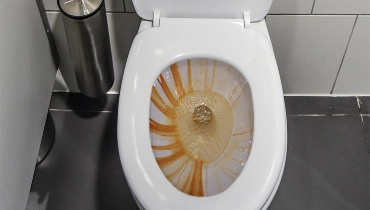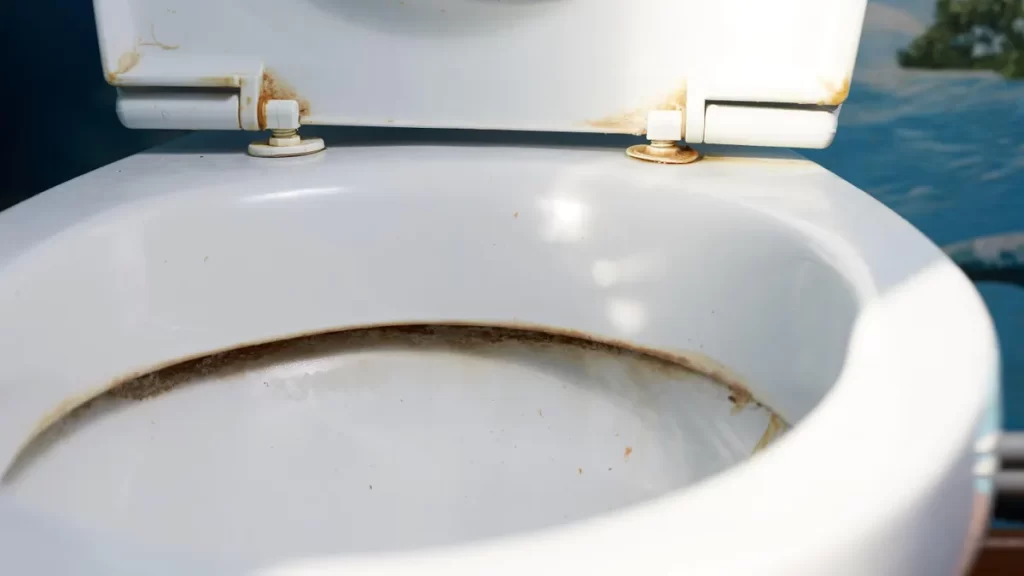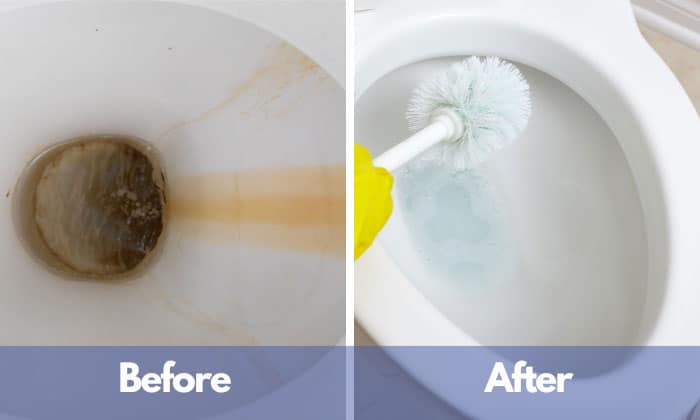Introduction

Rust stains in toilets are a common issue that many homeowners face, especially in older homes with deteriorating pipes. These red-brown color stains not only affect the aesthetics of your toilet bowl but can also indicate a deeper plumbing problem. This guide aims to provide you with effective methods to address and prevent these unsightly stains, ensuring your toilet remains clean and hygienic.
The Common Issue of Rust Stains in Toilets
Rust stains in the toilet bowl often result from high levels of iron in the water supply. This can be due to iron plumbing pipes, especially in older homes, or from a water source rich in iron particulates. Over time, the iron reacts with the moisture in the toilet, leading to those embarrassing stains that can reflect poorly on your cleaning skills and give an impression of poor hygiene.
The Importance of Addressing Rust Stains for Aesthetics and Hygiene
While rust stains might seem like a mere cosmetic issue, they can be indicative of underlying plumbing and HVAC needs. A stained toilet can be a sign of deteriorating iron pipes or even rusty water heaters. Moreover, these stains, when combined with soap residue, can lead to a chemical reaction, producing even more stubborn stains.
Understanding the Causes
When you spot those unsightly red-brown rust stains in your toilet bowl, it’s natural to wonder where they come from. Rust stains in toilets, especially in an older home, can be attributed to several factors. Let’s dive deeper into understanding these causes.
Iron in Water Supply: How High Levels of Iron Lead to Rust Stains
Iron is a common mineral found in water, especially in well-water or areas with hard water. When there are high levels of iron in the water supply, it reacts with the oxygen in the air, forming iron oxide or rust. Over time, this rust accumulates on the porcelain surface of your toilet bowl, leading to those stubborn rust stains.
Water Softeners: Installing a water softener system can help in reducing the iron content in your water. Water softeners work by replacing iron and other minerals with sodium, thus preventing rust stains from forming.
Water Filtration System: Another effective way to tackle iron-rich water is by installing a water filtration system. This system filters out iron particulates and other pollutants in water, ensuring your toilet remains rust-free.
Old Pipes and Deteriorating Infrastructure
In older homes, the plumbing system often consists of iron pipes. As these pipes age, they corrode, releasing iron into the water supply. This not only leads to rust stains in the toilet bowl but can also affect the overall water quality. Replacing old iron pipes with modern PEX piping or copper piping can be a long-term solution.
Iron Bacteria and Its Role in Rust Formation
Iron bacteria is a type of bacteria that thrives in iron-rich water. These bacteria produce a slimy residue that, when combined with iron, forms rust. The presence of iron bacteria can lead to more pronounced rust stains and even a foul odor in the water. Regular cleaning using white vinegar or commercial rust removers can help in addressing this issue.
Other Contributing Factors
Corroding Copper Pipes Leading to Copper Stains
Apart from iron, high copper content in water can also lead to stains, albeit of a different hue. Corroding copper pipes release copper into the water, leading to blue or green stains. Regularly inspecting your plumbing system and replacing corroding pipes can prevent these stains.
Minerals Like Calcium and Limescale

Hard-water areas often have a high content of minerals like calcium. Over time, these minerals accumulate in the toilet bowl, leading to limescale formation and brown and yellow stains. Using a mixture of lemon juice and baking soda can help in removing these stains.
Mold Growth in Damp Conditions
Mold spores thrive in damp conditions. If your bathroom has poor ventilation, it can lead to mold growth, especially along grout lines. This mold can cause black or green stains in the toilet. Regular cleaning using bleach or other cleaning products can prevent mold growth.
Effective Methods to Remove Rust Stains
Dealing with rust stains in toilet can be a daunting task, especially if you’re unsure of the best methods to tackle them. But fear not! Whether you’re a fan of natural solutions or you trust commercial products more, there’s a method out there that’s perfect for you. Let’s delve into some tried-and-true techniques to get your toilet bowl sparkling clean.
Natural Solutions:
Natural solutions are a great choice if you’re looking for eco-friendly options that are gentle on your toilet’s porcelain surface and safe for the environment.
Vinegar and Baking Soda: A Powerful Combination for Rust Removal

- Pour white vinegar into the toilet bowl, ensuring it covers the rust stains.
- Sprinkle baking soda over the vinegar-soaked stains.
- Let the mixture sit for about 15 minutes. The acidic nature of the vinegar combined with the abrasive properties of baking soda will work to break down the rust.
- Use a toilet brush to scrub the stains gently.
- Once done, flush the toilet to rinse away the mixture and the rust.
Citric Acid: Using Fruits like Lemons and Limes
- Cut a lemon or lime in half.
- Rub the cut side of the fruit directly onto the rust stains.
- Allow it to sit for a few minutes. The citric acid in these fruits is effective in breaking down rust.
- Scrub the area with a non-abrasive scouring brush.
- Flush the toilet to rinse.
Cream of Tartar: A Gentle Abrasive for Rust Stains
- Make a paste using cream of tartar and a small amount of water.
- Apply this paste directly onto the rust stains.
- Let it sit for 10-15 minutes.
- Scrub gently using a toilet brush.
- Rinse by flushing the toilet.
Commercial Solutions:
For those stubborn rust stains that don’t seem to budge with natural remedies, commercial solutions might be your best bet.
The Role of Commercial Rust Removers
Commercial rust removers, like Bar Keepers Friend, are specially formulated to tackle tough rust stains in toilets. They contain chemicals that break down rust quickly and effectively.
- Wear rubber gloves and goggles for safety.
- Apply the rust remover as per the manufacturer’s instructions.
- Allow it to sit for the recommended time.
- Scrub the stains using a toilet brush.
- Flush the toilet to rinse away the product and the rust.
Preventing Future Rust Stains

While removing rust stains in toilet can be a challenge, preventing them from reoccurring is equally crucial. By addressing the root causes and maintaining regular cleaning routines, you can ensure that your toilet remains pristine and rust-free. Let’s explore some effective preventive measures.
Addressing Water Quality:
The quality of water in your home plays a significant role in the formation of rust stains in toilets. High levels of iron in the water supply can lead to those unsightly red-brown stains that mar the beauty of your toilet bowl.
Importance of Water Testing for Impurities
- Identify the Culprits: By testing your water, you can identify the presence of iron, sulfur, calcium, and other minerals that contribute to rust and other stains.
- Determine the Need for Treatment: Once you know the impurities in your water, you can decide on the best water treatment solutions.
Installing Water Filters and Softeners
- Water Filters: These devices remove pollutants in water, including iron particulates. Installing a water filtration system can significantly reduce the iron content in your water, preventing rust stains.
- Water Softeners: Hard-water areas often have a high mineral content. A water softener system replaces minerals like iron with sodium, preventing the formation of rust stains in the toilet bowl.
Regular Maintenance:
Routine maintenance is the key to a clean and stain-free toilet. By incorporating some simple practices into your cleaning routine, you can prevent rust stains from forming.
Routine Cleaning to Prevent Stain Buildup
- Weekly Cleaning: Use a toilet brush and a gentle cleaning solution to scrub the toilet bowl once a week. This prevents the buildup of rust and other stains.
- Avoid Harsh Chemicals: Chemical products like bleach can damage the porcelain surface, making it more susceptible to stains. Opt for eco-friendly options like white vinegar and baking soda.
Using Distilled White Vinegar for Deep Cleaning
- Natural Rust Remover: White vinegar, with its acidic nature, is effective in removing rust stains. Pour it into the toilet bowl, let it sit for a few minutes, and then scrub the stains using a toilet brush.
- Monthly Deep Cleaning: Once a month, turn off the water supply, empty the toilet bowl, and soak a toilet paper roll in white vinegar. Place this roll on the rust stains and let it sit overnight. The next morning, scrub away the stains and flush the toilet.
Precautions While Using Chemical Solutions
- Always read and follow the manufacturer’s instructions.
- Ensure the bathroom is well-ventilated when using chemical products.
- Keep these products out of reach of children and pets.
- Avoid mixing different cleaning products as it can lead to harmful chemical reactions.
Conclusion
Dealing with rust stains in toilet is more than just about aesthetics. It’s about ensuring a hygienic environment for you and your loved ones. Over the course of this guide, we’ve delved deep into the causes, solutions, and preventive measures for these stubborn stains.
The Significance of Proactive Measures
Being proactive is the key. By understanding the root causes, such as high levels of iron in the water supply or deteriorating pipes in an older home, you can take steps to prevent these stains from forming in the first place. Regular maintenance, using natural cleaning agents like white vinegar and baking soda, and addressing water quality can go a long way in keeping your toilet rust-free.
Ensuring a Clean and Stain-Free Toilet for a Comfortable Home Environment
A clean toilet is a reflection of your cleaning skills and attention to home maintenance. Beyond the embarrassment of having guests spot rust stains in your toilet bowl, it’s about ensuring a comfortable and hygienic environment in your home. With the right knowledge and tools, you can tackle and prevent rust stains, ensuring that your bathroom remains a clean and pleasant space.
FAQs:
Why do rust stains appear in my toilet bowl?
Rust stains primarily form due to high levels of iron in the water supply. This can be a result of iron pipes, well water, or even certain water sources. When iron-rich water sits in the toilet bowl, it can lead to those characteristic red-brown stains over time.
Are commercial rust removers safe for my toilet?
Most commercial rust removers are safe for toilets, especially those designed for bathroom use. However, it’s essential to follow the manufacturer’s instructions and ensure the bathroom is well-ventilated when using chemical products. Always avoid mixing different cleaning products, as this can lead to harmful chemical reactions.
How can I prevent rust stains from reappearing in my toilet?
Prevention is a combination of regular maintenance and addressing the root causes. Regularly cleaning the toilet using non-abrasive cleaners like white vinegar can prevent stain buildup. Additionally, addressing water quality by installing water softeners or filters can reduce the iron content in the water, preventing rust stains.

